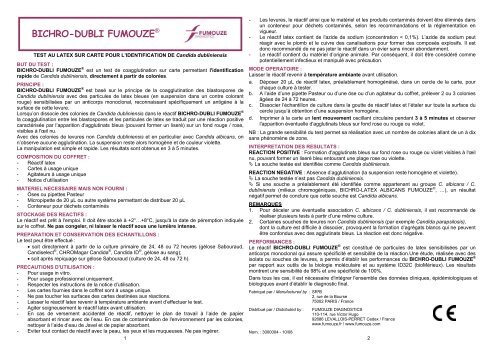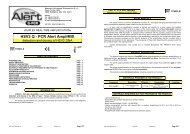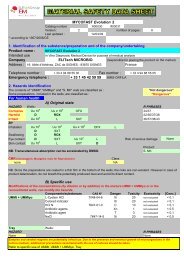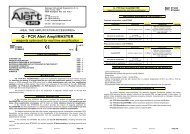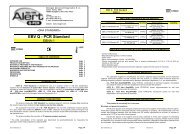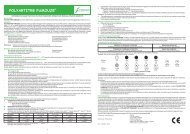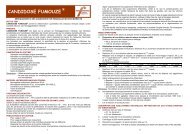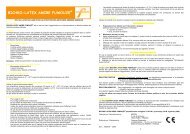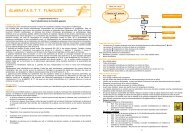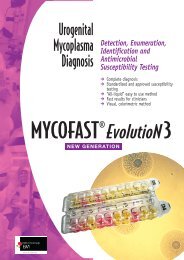BICHRO-DUBLI FUMOUZE®
BICHRO-DUBLI FUMOUZE®
BICHRO-DUBLI FUMOUZE®
- No tags were found...
Create successful ePaper yourself
Turn your PDF publications into a flip-book with our unique Google optimized e-Paper software.
<strong>BICHRO</strong>-<strong>DUBLI</strong> FUMOUZE ®TEST AU LATEX SUR CARTE POUR L’IDENTIFICATION DE Candida dubliniensisBUT DU TEST :<strong>BICHRO</strong>-<strong>DUBLI</strong> FUMOUZE ® est un test de coagglutination sur carte permettant l'identificationrapide de Candida dubliniensis, directement à partir de colonies.PRINCIPE :<strong>BICHRO</strong>-<strong>DUBLI</strong> FUMOUZE ® est basé sur le principe de la coagglutination des blastospores deCandida dubliniensis avec des particules de latex bleues (en suspension dans un contre colorantrouge) sensibilisées par un anticorps monoclonal, reconnaissant spécifiquement un antigène à lasurface de cette levure.Lorsqu’on dissocie des colonies de Candida dubliniensis dans le réactif <strong>BICHRO</strong>-<strong>DUBLI</strong> FUMOUZE ®la coagglutination entre les blastospores et les particules de latex se traduit par une réaction positivecaractérisée par l’apparition d'agglutinats bleus (pouvant former un liseré) sur un fond rouge / rose,visibles à l'œil nu.Avec des colonies de levures non Candida dubliniensis et en particulier avec Candida albicans, onn’observe aucune agglutination. La suspension reste alors homogène et de couleur violette.La manipulation est simple et rapide. Les résultats sont obtenus en 3 à 5 minutes.COMPOSITION DU COFFRET :- Réactif latex- Cartes à usage unique- Agitateurs à usage unique- Notice d’utilisationMATERIEL NECESSAIRE MAIS NON FOURNI :- Öses ou pipettes Pasteur- Micropipette de 20 µL ou autre système permettant de distribuer 20 µL- Conteneur pour déchets contaminésSTOCKAGE DES REACTIFS :Le réactif est prêt à l'emploi. Il doit être stocké à +2°…+8°C, jusqu'à la date de péremption indiquéesur le coffret. Ne pas congeler, ni laisser le réactif sous une lumière intense.PREPARATION ET CONSERVATION DES ECHANTILLONS :Le test peut être effectué :• soit directement à partir de la culture primaire de 24, 48 ou 72 heures (gélose Sabouraud,Candiselect ® , CHROMagar Candida ® , Candida ID ® , gélose au sang);• soit après repiquage sur gélose Sabouraud (culture de 24, 48 ou 72 h).PRECAUTIONS D'UTILISATION :- Pour usage in vitro.- Pour usage professionnel uniquement.- Respecter les instructions de la notice d’utilisation.- Les cartes fournies dans le coffret sont à usage unique.- Ne pas toucher les surfaces des cartes destinées aux réactions.- Laisser le réactif latex revenir à température ambiante avant d’effectuer le test.- Agiter soigneusement le réactif latex avant utilisation.- En cas de versement accidentel de réactif, nettoyer le plan de travail à l’aide de papierabsorbant et rincer avec de l’eau. En cas de contamination de l'environnement par les colonies,nettoyer à l’aide d’eau de Javel et de papier absorbant.- Eviter tout contact de réactif avec la peau, les yeux et les muqueuses. Ne pas ingérer.- Les levures, le réactif ainsi que le matériel et les produits contaminés doivent être éliminés dansun conteneur pour déchets contaminés, selon les recommandations et la réglementation envigueur.- Le réactif latex contient de l'azide de sodium (concentration < 0,1%). L’azide de sodium peutréagir avec le plomb et le cuivre des canalisations pour former des composés explosifs. Il estdonc recommandé de ne pas jeter le réactif dans un évier sans rincer abondamment.- Le réactif contient du matériel d’origine animale. Par conséquent, il doit être considéré commepotentiellement infectieux et manipulé avec précaution.MODE OPERATOIRE :Laisser le réactif revenir à température ambiante avant utilisation.a. Déposer 20 µL de réactif latex, préalablement homogénéisé, dans un cercle de la carte, pourchaque culture à tester.b. A l’aide d’une pipette Pasteur ou d’une öse ou d’un agitateur du coffret, prélever 2 ou 3 coloniesâgées de 24 à 72 heures.c. Dissocier l’échantillon de culture dans la goutte de réactif latex et l’étaler sur toute la surface ducercle jusqu’à obtention d’une suspension homogène.d. Imprimer à la carte un lent mouvement oscillant circulaire pendant 3 à 5 minutes et observerl'apparition éventuelle d'agglutinats bleus sur fond rose ou rouge ou violet.NB : La grande sensibilité du test permet sa réalisation avec un nombre de colonies allant de un à dixsans phénomène de zone.INTERPRETATION DES RESULTATS :REACTION POSITIVE : Formation d'agglutinats bleus sur fond rose ou rouge ou violet visibles à l'œilnu, pouvant former un liseré bleu entourant une plage rose ou violette. La souche testée est identifiée comme Candida dubliniensis.REACTION NEGATIVE : Absence d’agglutination (la suspension reste homogène et violette). La souche testée n’est pas Candida dubliniensis. Si une souche a préalablement été identifiée comme appartenant au groupe C. albicans / C.dubliniensis (milieux chromogéniques, <strong>BICHRO</strong>-LATEX ALBICANS FUMOUZE ® , …), un résultatnégatif permet de conclure que cette souche est Candida albicans.REMARQUES1. Pour déceler une éventuelle association C. albicans / C. dubliniensis, il est recommandé deréaliser plusieurs tests à partir d’une même culture.2. Certaines souches de levures non Candida dubliniensis (par exemple Candida parapsilosis),dont la culture est difficile à dissocier, provoquent la formation d’agrégats blancs qui ne peuventêtre confondus avec des agglutinats bleus. La réaction est donc négative.PERFORMANCES :Le réactif <strong>BICHRO</strong>-<strong>DUBLI</strong> FUMOUZE ® est constitué de particules de latex sensibilisées par unanticorps monoclonal qui assure spécificité et sensibilité de la réaction.Une étude, réalisée avec desisolats ou souches de levures, a permis d’établir les performances du <strong>BICHRO</strong>-<strong>DUBLI</strong> FUMOUZE ®par rapport aux outils de la biologie moléculaire et au système ID32C (bioMérieux). Les résultatsmontrent une sensibilité de 98% et une spécificité de 100%.Dans tous les cas, il est nécessaire d'intégrer l'ensemble des données cliniques, épidémiologiques etbiologiques avant d’établir le diagnostic final.Fabriqué par / Manufactured by : SR²B2, rue de la Bourse75002 PARIS / FranceDistribué par / Distributed by :FUMOUZE DIAGNOSTICS110-114, rue Victor Hugo92686 LEVALLOIS-PERRET Cedex / Francewww.fumouze.fr / www.fumouze.comNom. : 3000004 - 10/081 2
<strong>BICHRO</strong>-<strong>DUBLI</strong> FUMOUZE ®LATEX CARD TEST FOR THE IDENTIFICATION OF Candida dubliniensisINTENDED USE:<strong>BICHRO</strong>-<strong>DUBLI</strong> FUMOUZE ® is a latex coagglutination card test for the rapid identification of Candida dubliniensis,directly from colonies.PRINCIPLE:<strong>BICHRO</strong>-<strong>DUBLI</strong> FUMOUZE ® is based on the coagglutination principle of blastopores of Candida dubliniensis with bluelatex particles (in suspension in a red dye) coated with a monoclonal antibody, which allows the specific detection ofCandida dubliniensis antigen located on the surface of the cell.Candida dubliniensis colonies dissociation in the <strong>BICHRO</strong>-<strong>DUBLI</strong> FUMOUZE ® reagent is revealed by a coagglutination betweenthe blastospores which carry the antigen and the latex particles sensitized with the monoclonal antibody, visible to the naked eye:blue agglutinates progressively spread towards the periphery, forming a blue edge around a central red/pink area.With non-Candida dubliniensis yeasts, in particular with Candida albicans, there is no agglutination. Then, the reagentkeeps its original appearance (homogeneous purple suspension).The test procedure is easy and rapid. The results are obtained between 3 and 5 minutes.KIT CONTENT:- Latex reagent- Disposable cards- Disposable stirrers- Package insertMATERIAL REQUIRED BUT NOT PROVIDED:- Platinum loop or Pasteur pipettes- Micropipette delivering 20 µL- Container for contaminated wastesSTORAGE CONDITIONS:Reagent is ready-to-use.Store at +2°…+8°C, until the expiry date indicated on the box.Do not freeze. Do not expose the reagent to strong light.SAMPLES HANDLING AND STORAGE:The test can be performed:• directly from primary 24, 48 to 72 hours culture (Sabouraud agar, Candiselect ® , chromagar Candida ® , Candida ID ® ,blood agar);• from Sabouraud agar subcultured colonies (24, 48 to 72 hours culture).WARNINGS AND PRECAUTIONS:- For in vitro diagnostic use.- Only for professional use.- Follow the instructions for use.- The cards provided in the kit are disposable.- Do not touch the surfaces of the cards which are used for analysis.- Allow reagent to return to room temperature prior to testing.- Carefully shake the latex reagent before use.- In case of accidental spill of reagent, clean the surface with absorbent paper and water. In case of environmentcontamination by colonies, clean the surface with absorbent paper and bleach.- Avoid contact of reagent with skin, eyes and mucous membranes. Do not ingest.- The colonies, the reagent as well as the contaminated materials and products must be eliminated in a container forcontaminated wastes, according to the prevailing recommendations and regulations.- Latex reagent contains < 0.1% sodium azide which may react with lead and copper plumbing to form explosive metalazides. Azide built-up can be avoided by flushing with large volumes of water following the disposal of reagent.- Latex reagent contains material of animal origin. As a consequence, it has to be handled with care as hazardous components.TEST PROCEDURE:Before use, allow the reagent to return to room temperature.a. Distribute 20 µL of previously homogenized latex reagent, in one card circle, for each specimen to test.b. With a Pasteur pipette or a platinum loop, pick out 2 to 3 colonies to test.c. Dissociate colonies into the latex reagent drop and spread it into the complete circle area, until suspension is homogeneous.d. Rock the card gently with a rotary motion and observe the presence or the absence of agglutination within 3 to 5 minutes.NB The high sensitivity of <strong>BICHRO</strong>-<strong>DUBLI</strong> FUMOUZE ® allows the test with one to ten colonies without prozone effect.INTERPRETATION OF THE RESULTS:POSITIVE REACTION: Presence of blue-coloured agglutinates which progressively spread towards the periphery, forminga blue edge around a central red/pink/purple/violet area. The unknown specimen is identified as Candida dubliniensis.NEGATIVE REACTION: No agglutination (the suspension keeps its homogeneous original aspect). The unknown specimen is not Candida dubliniensis. If a strain was previously identified as belonging to the group Candida albicans / Candida dubliniensis (chromogenicmedia, <strong>BICHRO</strong>-LATEX ALBICANS FUMOUZE ® …), a negative result allows confirming the strain is Candida albicans.NOTES1. To detect a possible association Candida albicans / Candida dubliniensis, it is recommended to realize from one cultureseveral tests.2. Colonies of some non-Candida dubliniensis isolates (Candida parapsilosis for example) may be difficult to dissociate,forming white aggregates that cannot be confused with blue agglutinates. Therefore, the reaction is negative.PERFORMANCE CHARACTERISTICS:<strong>BICHRO</strong>-<strong>DUBLI</strong> FUMOUZE ® reagent is composed of latex particles coated with a monoclonal antibody. It ensures sensitivityand specificity to the reaction. A study, realized on isolated yeasts, allowed to draw up the performances of <strong>BICHRO</strong>-<strong>DUBLI</strong>FUMOUZE ® against molecular biology diagnostic and ID32C system (BioMerieux). The results show a sensitivity of 98 % and aspecificity of 100 % (communication of MAROT A., 2004, Evaluation d'un test au latex pour l'identification rapide de Candidadubliniensis, Société Française de Microbiologie-Bordeaux).In any case, diagnosis should be made using the results of this test together with the other clinical, epidemiological andlaboratory findings.BIBLIOGRAPHIE / REFERENCES:1. ADOU-BRYN, K., DOUCHET, C., FERRER, A., GRIMAUD, L., ROBERT, R. AND RICHARD-LENOBLE, D., 2003. Morphologicalfeatures of Candida dubliniensis on a modified Pal's medium. Preliminary study. J. Mycol. Méd., 13 : 99-103.2. AL-MOSAID, A., SULLIVAN, D., COLEMAN, D.C., 2003. Differentiation of Candida dubliniensis from Candida albicans on Pal's agar. J.Clin. Microbiol., 41: 4787-4789.3. AL-MOSAID, A., SULLIVAN, D., SALKIN, I. F., SHANLEY, D., COLEMAN, D. C., 2001. Differentiation of Candida dubliniensis fromCandida albicans on Staib agar and caffeic acid-ferric citrate agar. J. Clin. Microbiol., 39 : 323-327.4. BIKANDI, J., SAN MILLÁN, R., MORAGUES, M. D., CEBAS, G., CLARKE, M., COLEMAN, D. C., SULLIVAN, D. J., QUINDÓS, G.,PONTÓN, J., 1998. Rapid identification of Candida dubliniensis by indirect immunofluorescence based on differential localization ofantigens on C. dubliniensis blastospores and Candida albicans germ tubes. J. Clin. Microbiol., 36 : 2428-2433.5. COLEMAN, D., SULLIVAN, D., BENNET, G. P., MORAN, G., BARRY, H., SHALEY, D., 1997a. Candidiasis, the emergence of a novelspecies, Candida dubliniensis. AIDS, 11 : 557-567.6. COLEMAN, D., SULLIVAN, D., HAYENS, M., HENMAN, M., SHANLEY, D., BENNET, D., 1997b. Molecular and phenotypic analysis of Candidadubliniensis, a recently identified species linked with oral candidiasis in HIV-infected and AIDS patients. Oral Dis, 3 : 96-101.7. DONNELLY, S. M., SULLIVAN, D. J., SHANLEY, D. B., COLEMAN, D. C., 1999. Phylogenetic analysis and rapid identification ofCandida dubliniensis based on analysis of ACT1 intron and exon sequences. Microbiology, 145 : 1871-1882.8. GUTIÉRREZ, J., MORALES, P., GONZALES, M. A., QUINDOS, G., 2002. Candida dubliniensis, a new fungal pathogen : review. J.Basic Microbiol., 42 : 207-227.9. JOLY, S., PUJOL, C., RYSZ, M., VARGAS, K., SOLL, D. R., 1999. Development and characterization of complex DNA fingerprintingprobes for the infectious yeast Candida dubliniensis. J. Clin. Microbiol., 37 : 1035-1044.10. KURZAI, O., HEINZ, W. J., SULLIVAN, D. J., COLEMAN, D. C., FROSCH, M., MUHLSCHLEGEL, F. A., 1999. Rapid PCR test fordiscriminating between Candida albicans and Candida dubliniensis isolates using primers derived from the pH-regulated PHR1 andPHR2 genes of Candida albicans. J. Clin. Microbiol., 37 : 1587-1590.11. MAROT-LEBLOND, A., GRIMAUD, L., NAIL, S., BOUTERIGE, S., APAIRE-MARCHAIS, V., SULLIVAN, D. J., ROBERT, R., 2000. Newmonoclonal antibody specific for Candida albicans germ tube. J. Clin. Microbiol., 38 : 61-67.12. MEYER, W., MASZEWSKA, K., SORREL, T. C., 2001. PCR fingerprinting, a convenient molecular tool to distinguish between Candidadubliniensis and Candida albicans. Med. Mycol., 39 : 185-193.13. ODDS, F. C., NUFFEL, L. V., DAMS G., 1998. Prevalence of Candida dubliniensis isolates in a yeast stock collection. J. Clin. Microbiol.,36 : 2869-2873.14. PARK, S., WONG, M., MARRAS, S. A., CROSS, E. W., KIEHN, T. E., CHATURVEDI, V., TYAGI, S., PERLIN, D. S., 2000. Rapididentification of Candida dubliniensis using a species-specific molecular beacon. J. Clin. Microbiol., 38 : 2829-2836.15. PELTROCHE-LLACSAHUANGA, H., SCHMIDT, S., SEIBOLD, M., LUTTICKEN, R., HAASE, G., 2000. Differentiation between C.dubliniensis and C. albicans by fatty acid methyl ester analysis using gas liquid chromatography. J. Clin. Microbiol., 38 : 3696-3704.16. PINJON, E., SULLIVAN, D., SALKIN, I., SHANLEY, D., COLEMAN, D. C., 1998. Simple inexpensive, reliable method for differentiation ofCandida dubliniensis from Candida albicans. J. Clin. Microbiol., 6 : 2093-2095.17. STAIB, P., MORSCHHÄUSER, J., 1999. Chlamydospore formation on Staib agar as species-specific characteristic of Candidadubliniensis. Mycoses, 42 : 521-524.18. SULLIVAN, D., COLEMAN, D., 1998. Candida dubliniensis, characteristics and identification. J. Clin. Microbiol., 36 : 329-334.19. SULLIVAN, D. J., MORAN, G., DONNELLY, S., GEE, S., PINJON, E., MCCARTAN, B., SHANLEY, D. B., COLEMAN, D. C., 1999.Candida dubliniensis, An update. Rev. Iberoam. Micol., 16 : 72-76.20. SULLIVAN, D. J., WESTERNENG, T. J., HAYNES, K. A., BENNET, D. E., COLEMAN, D. C., 1995. Candida dubliniensis sp. nov.,phenotypic and molecular characterization of a novel species associated with oral candidosis in HIV-infected individuals. Microbiology,141 : 1507-1521.21. WILLIAMS, D. W., COULTER, W. A., WILSON, M. J., POTTS, A. J., LEWIS, M. A. O., 2001. Identification of Candida dubliniensis, basedon ribosomal DNA sequence analysis. Br. J. Biomed. Sci., 58 : 11-16.22. MAROT LEBLOND, A., BEUCHER, B., DAVID, S., NAIL-BILLAUD, S., ROBERT, R., 2006, Development and evaluation of a rapid latexagglutination test using a monoclonal antibody to identify Candida dubliniensis colonies. J. Clin. Microbiol., 44 : 138-142.23. SAHAND, I.H., MORAGUES, M.D., ROBERT, R., QUINDOS, G., PONTON, J., 2006, Evaluation of Bichro-Dubli Fumouze ® to distinguishCandida dubliniensis from Candida albicans. Diagnostic Microbiology and Infectious Disease, 55 : 165-167.24. CHRYSSANTHOU, E., FERNANDEZ, V., PETRINI, B., 2007, Performance of commercial latex agglutination tests for the differenciationof Candida dubliniensis and Candida albicans in routine diagnostics. APMIS, 115: 1281-1284.3 4


